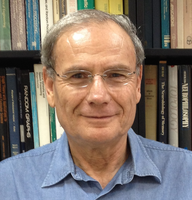The Subcritical Brain and Motion Control
Speaker: Yarom Baram ‚Äď Israel Institute of Technology, Israel
Őż
.
Abstract: Starting with an elementary definition of cortical linguistics, letters and words are defined by neurons and neural circuits, which, in turn, follow the elements of mathematical graphs. These are shown to go a long way in building cortical structures and explaining their functional purposes. Mathematical properties, such as number primality and neural circuit categories, are found to resolve the wonders of large-scale information storage and retrieval by relatively small neural circuits. Cortical dynamics, driving memory storage and retrieval as well as mechanical operations, such as motion, are shown to be managed by a variety of neural circuit firing rates, ranging from chaos, through oscillation, to silence, are, in turn, driven by neural circuits interaction. Some end results, including motion control in the neurologically impaired, are explained and illustrated by examples.
Biography: Professor Yoram Baram of the Computer Science department at the Technion ‚Äď Israel Institute of Technology, received the BSc degree in Aeronautical Engineering from the Technion in 1972, the MSc degree in Aeronautics and Astronautics from MIT in 1974, and the PhD degree in Electrical Engineering and Computer Science from MIT in 1976. Until 1988 he was mainly investigating theoretical issues of control systems. Between 1989 and 1998 he was mainly investigating the theory of artificial neural networks. A 1999 incidental acquaintance with movement impairments in patients with Parkinson‚Äôs disease has led him to the development of a closed-loop virtual-reality device for gait entrainment, for which he received a US patent in 2004. The device has proved to be highly effective for gait improvement in a variety of other neurological disorders, such as multiple sclerosis, cerebral palsy, brain stroke and senile gait. Around 2012 he became particularly interested in mathematical neuroscience, which he found to be consistent with experimental findings. His work has been published in the leading scientific journals, and has been recently summoned in two books published by World Scientific: ‚ÄúThe Subcritical Brain‚ÄĚ (2021) and ‚ÄúMotion Control‚ÄĚ (2023).

